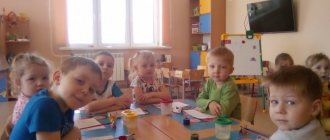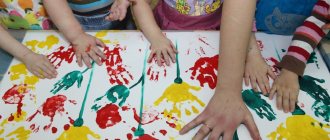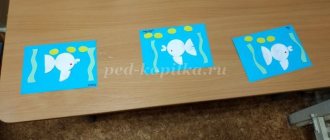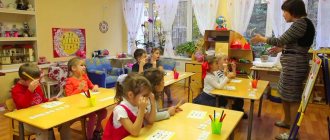Lesson notes for art activities 1st junior. "We decorate the house"
Abstract lesson on artistic activities - 1st junior group
"Our houses"
Target:
continue to arouse children's interest in drawing
Tasks:
Encourage children to use paints of 2 colors.
Fix the name of green and yellow flowers.
Create a feeling of joy from the work done.
Progress of the lesson
The teacher calls the children over and begins to talk with them about fairy tales. In my hands is a book of the fairy tale “Teremok” - Guys, what fairy tale do you think is hidden in this book? (Teremok). - How did you guess? (By the picture on the cover, by animals, etc.). - And who lives in this fairy tale? (children's answers: mouse, frog, bear, etc.). - Yes! These are the little mouse, the frog, the runaway bunny, the sister fox, the wolf-gray tail and the clubfoot bear. - Look, here they are - the inhabitants of the tower (The teacher draws the children’s attention to the board with hanging animals). - Guys, do you know what the bear did in this fairy tale? (Children's answers).
- Yes, the bear broke their house. - why did he break it? (Because the bear was big and heavy!) - Where should they live now? After all, they need a house! - Guys, remember, you and I have already made houses for our animals. - Remember how you made them? (Glued, sculpted). - What do you think needs to be done to make these houses even more beautiful and appeal to our forest animals? (Color with paints.) - Do you want to color them? (Yes).
(Material has been prepared in advance in the form of cut-out animals from a fairy tale, children are divided into small groups)
(teacher addresses children)
- Eva, who would you like to decorate the house for
?
(For…). Here, take yourself a fox.
And you, Katya, who do you want to decorate the house for? Here's a runaway bunny for you. And Roma got a clumsy bear. (Each child gets one animal).
Then sit down at the tables.
Place your animals nearby. They will watch you decorate the house for them! (Children sit down at the tables)
- Let’s first stretch our fingers so that they can make the houses very beautiful.
Finger gymnastics “Toys”
I play with toys: (Hands in front of you, clench and unclench the fingers of both hands.)
I throw the ball to you, (We stretch our arms forward - “throw the ball.”)
I’m assembling a pyramid (we place straight hands, palms down, one on top of each other.
repeatedly.)
I drive the truck everywhere. (Move your right hand in front of you with a slightly open hand -
"Let's roll the car.")
- Well, our fingers are warmed up
, have warmed up and now you can start
decorating the houses
.
— There are houses
.
Look, what else do you have on your tables? (Paint, brushes, cotton swabs, water)
- Sit up straight, legs straight, sleeves rolled up so as not to stain them.
— Take the brushes in your hands correctly, with two fingers. Dip it in water, then in the paint of your choice. We already know how to use both cotton swabs and brushes.
(Introduction to the rules of washing your brush after painting
paint one color in order to use another.) Reinforcing the names of paint colors. Individual assistance. Watch the landing.)
- What beautiful houses you make, all colored
!
- And the fox and the wolf, and the bunny and the mouse, and the bear and the frog will really like the houses
!
- Let's now hang up our works and look at them.
Summary of drawing lesson “Draw a house”
Tasks:
1. Correctional and educational:
Consolidating knowledge about colors and geometric shapes of objects.
Continuing to teach children how to create simple compositions.
2. Correctional and developmental:
Development of cognitive processes: perception, memory, thinking.
Execution of the drawing according to the sample. Demonstration and explanation by the teacher of the main method of examining the subject. Focus on the sequence of actions to complete tasks. Memorizing a sequence of actions, switching from one action to another (changing colored pencils).
Development of observation skills.
Using visual supports (arrangement of objects on a flannelgraph) to attract children's attention to the addressed speech, developing its understanding.
Continuation of training in basic planning of upcoming activities. Using drawing techniques learned during activities outside of class.
Development of creativity.
An action plan is proposed by the teacher. Operational control of an adult: use of explanations and instructions.
Improving the lexical composition of oral speech.
Children naming an object, a sample and its parts, designating their signs using speech, the purpose of the object, the location of the object in space (inside-outside, top-bottom, left-right). Brief answers to the teacher’s questions, repetition of the teacher’s task (instructions).
3. Correctional and educational:
Attracting children's attention to the topic of drawing in everyday household activities and in the lesson itself.
Formation of accuracy skills in work.
Development of emotional responsiveness.
Material for the lesson – drawing “Draw a house”, simple and colored pencils (12 colors), album sheets.
Work should begin with developing the ability to deliberately consider, i.e. visually examine. Under the guidance of a teacher, children isolate the main elements and details of an object, determine their relationship, position in space, and notice changes in the object itself or its location. Repeated completion of such tasks contributes to the development of observation, which in turn allows the child to form a holistic and at the same time detailed idea of the object.
Before the lesson, preliminary work must be done - remember what geometric shapes were studied in previous classes, find the shapes in the surrounding space (in a group), pronounce (a window is a rectangle, a mirror is a circle, the roof of a dollhouse is a triangle, etc.), viewing illustrations in order to arouse interest in the upcoming lesson, the activity of children, the desire to engage in visual activities in general.
Lesson structure:
Introductory part - 3 min.
A conversation about the components of the house (walls, roof, window), about what can be drawn next to the house, familiarization with the composition on a flannelgraph for example - 5 minutes.
Physical exercise (finger gymnastics) - 2 min.
The main part of the lesson is 20 minutes.
Lesson summary: 5 min.
Progress of the lesson:
Introductory part
“Guys, we read a fairy tale about Little Red Riding Hood, who went to visit her grandmother. Today in class we will draw the house where my grandmother lived. Let's remember what kind of houses we know? The response of children (big and small) is expected here. They also simultaneously monitor how the teacher builds a composition on a flannelgraph. Then the structure of the image in the picture, the shape, proportions and arrangement of parts of the house are analyzed.
P.: “Does the house stand on the ground or hang in the air, or is it located in the sky?”
D.: “Below.” "On the ground".
P.: “Every house has walls (a wall is placed on the flannelgraph - a yellow rectangle). Please note that the rectangle is even and the lines are straight. What else needs to be built to make a house?”
D: “Roof” (in chorus). “Mom” (one hesitant answer).
P: “That’s right, the roof. The roof is on top of the walls and protects the house from rain and snow, so it fits tightly to the walls of the house so that neither snow nor raindrops get into the house. The roof is triangular in shape. Please note that all sides of the roof are level. What else is missing in our house?”
D: “Stola.” "TV." "Parents."
P: “Let’s think about it. Grandmother lives in the house. But how can she get into the house?
D: “We need a door.”
P: “We need to draw a door. We'll draw it on the left. The door is rectangular in shape, look carefully at the size it is smaller than the wall. Draw it beautifully, evenly. Let it be open (see sample) so that grandma can enter the house. You must remember to draw a staircase (based only on the sample, without verbal instructions). Do you remember?
D: “We still need to draw a window.”
P: “We will definitely draw a window. Do you remember what and in what order we will draw? Repeat."
D: “Walls. The roof. Door".
P: “That’s right. Well done. It’s very good that you remembered about the window. Windows come in different shapes: square, rectangular, and even round. We will draw a square window. There will be one window in the center of the wall. Try to draw it beautifully, neatly.”
Consolidating the concepts of spatial orientation. Then there is an analysis of the color in the picture - green grass grows on the ground, the sky is blue, the sun is yellow. And after all this - a holistic perception of the picture.
Fizminutka (finger gymnastics)
Knock-knock-knock, knock-knock-knock. There is a knock again.
The other finger on your hand tapped the thumb.
We will all take turns tapping our fingers and, of course, rest.
Now we'll be pussies. Hey, don't come too close.
Let's scratch it a little. We are not guys, but cats.
Now let's start drawing.
The main part of the lesson is children's independent activity.
First, a sketch of the drawing is made with a simple pencil. “We look carefully, remember how round the sun is, high in the sky. Home is on the ground." “Let's take a sheet of paper, a yellow pencil and color the sun. Now the grass is green. Where is our green pencil?
Individual work with children is carried out; the teacher approaches each child and guides the child with recommendations.
The final part.
P: “Guys, class is over. Show what you got. Did you do everything right?”
Children show their drawings. Everyone is happy with the results of their work. They believe that no one makes mistakes. When a teacher points out mistakes, children do not react to the teacher’s words and do not get upset. Analysis of children's drawings.
Bibliography:
1. E.A. Erzhanova. Visual activities in the training and education of preschoolers with developmental disabilities. // Defectology. - 2003. - No. 6
2. Teaching children with intellectual disabilities: (Oligophrenopedagogy): textbook. manual for university students / pod. ed. B.P. Puzanova. — 2nd ed., erased. - M.: Publishing House, 2006
3. Fundamentals of special psychology: Textbook for students of secondary pedagogical institutions L.V. Kuznetsova, L.I. Peresleni, L.I. Solntseva and others; edited by L.V. Kuznetsova. — 2nd ed., erased. - M.: Publishing House, 2005. - 480 p.




